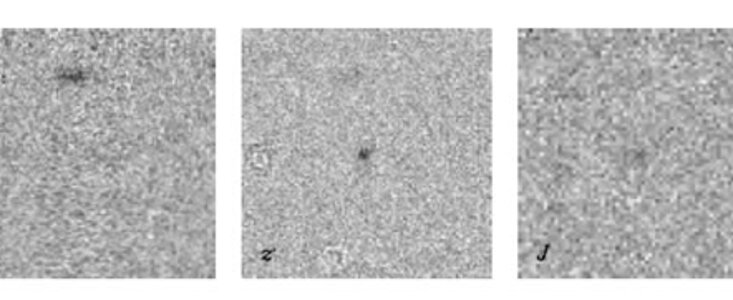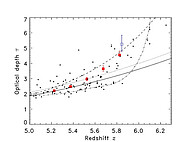Most Distant Quasar Samples Conditions in the Young Universe
24 September 2007
Chris Willott (University of Ottawa) and a large international research team identified four new quasars at redshift greater than z = 6 from MegaCam imaging at the Canada-France-Hawaii Telescope (CFHT). Follow-up spectroscopy with GMOS at the Gemini South telescope (and the Marcario LRS at the Hobby-Ebbberly Telescope) allowed the team to determine accurate redshifts. The team found what is now the most distant known quasar, CFHQS J2329-0301 at z = 6.43 (Figures 1 and 2).
Willott et al. also used the spectra to investigate constraints on the ionization sate of the intergalactic medium at that early age of the universe. Analysis of two of these quasar spectra revealed evidence that the reionization period is considerably longer than predicted by most theoretical models. From the time of recombination, (about 380,000 years after the Big Bang when protons and electrons combined into neutral hydrogen), the universe remained in this state for the following few hundred million years when there were no stars or galaxies. This period is referred to as the Dark Ages because of the absence of light sources. The first stars and quasars are surmised to have been the first generation of objects powerful enough, as a source of ultraviolet radiation, to have ionized almost all the gas in the universe - hence the process is called reionization.
The GMOS South spectra were taken in the nod-and-shuffle mode which produces excellent subtraction of the night sky spectrum. This is crucial for observations such as these where it is necessary to measure the weak residual flux at wavelengths shorter than the Lyman emission line in order to determine the absorption by neutral hydrogen.
The spectra were analyzed in two different ways to infer the ionization state of the high-redshift intergalactic medium. The spectral extent at which flux is visible at wavelengths shorter than the Lyman alpha peak gives the size of the proximity zone near the quasar. This proximity zone is ionized by the quasar and its growth during the quasar activity depends upon several factors including the ionization state of the gas before the quasar turned on. For both CFHQS quasars, at z=6.12 and z=6.43, these proximity zones are relatively large, indicating that the gas around these quasars had been substantially pre-ionized before the quasars turned on. Therefore, these locations in the universe seem to have already experienced reionization.
The GMOS spectra were also used to measure the Lyman transmitted flux as a function of wavelength. This allows the evolution of the optical depth to be determined. The optical depth shows strong evolution from z = 5 to z = 6 (Figure 3). This evolution is considerably more rapid than a simple extrapolation in optical depth evolution from lower redshift quasars and is interpreted as evidence for the tail-end of reionization continuing until a redshift of about six.
In summary, these two results appear to be rather contradictory at first sight. The proximity zones suggest a highly ionized intergalactic medium at z > 6, whereas the optical depth evolution suggests reionization continuing to z ~ 6. This is in contrast to the rapid “overlap” phase of reionization expected from most theoretical models. One caveat is that the universe does not look the same everywhere and may well not have been reionized everywhere at the same time. More quasars at z > 6 are required to resolve this puzzle.
Links
- “Four quasars above redshift 6 discovered by the Canada-France High-z Quasar Survey" by Willott et al. in press for the Astronomical Journal.




